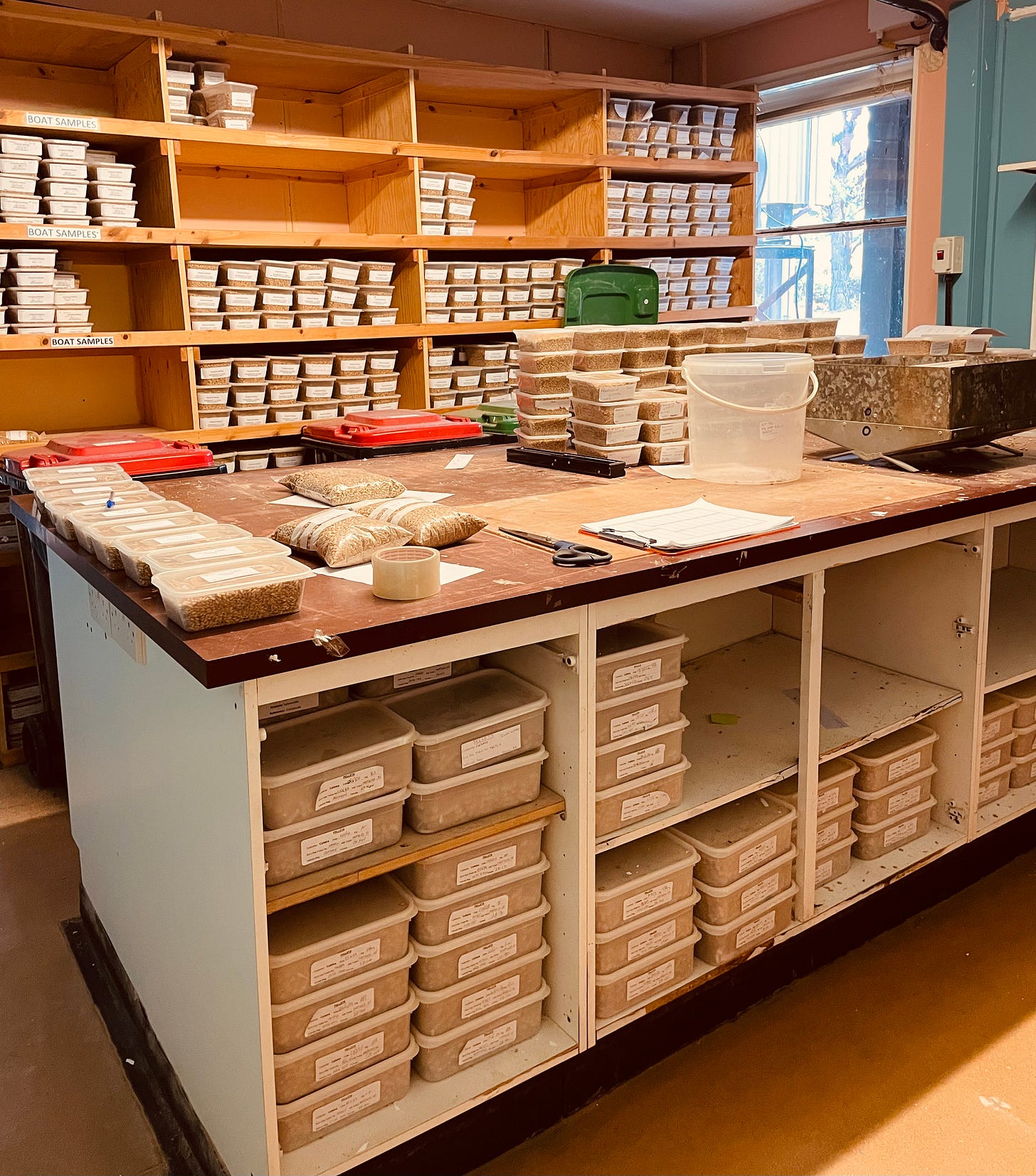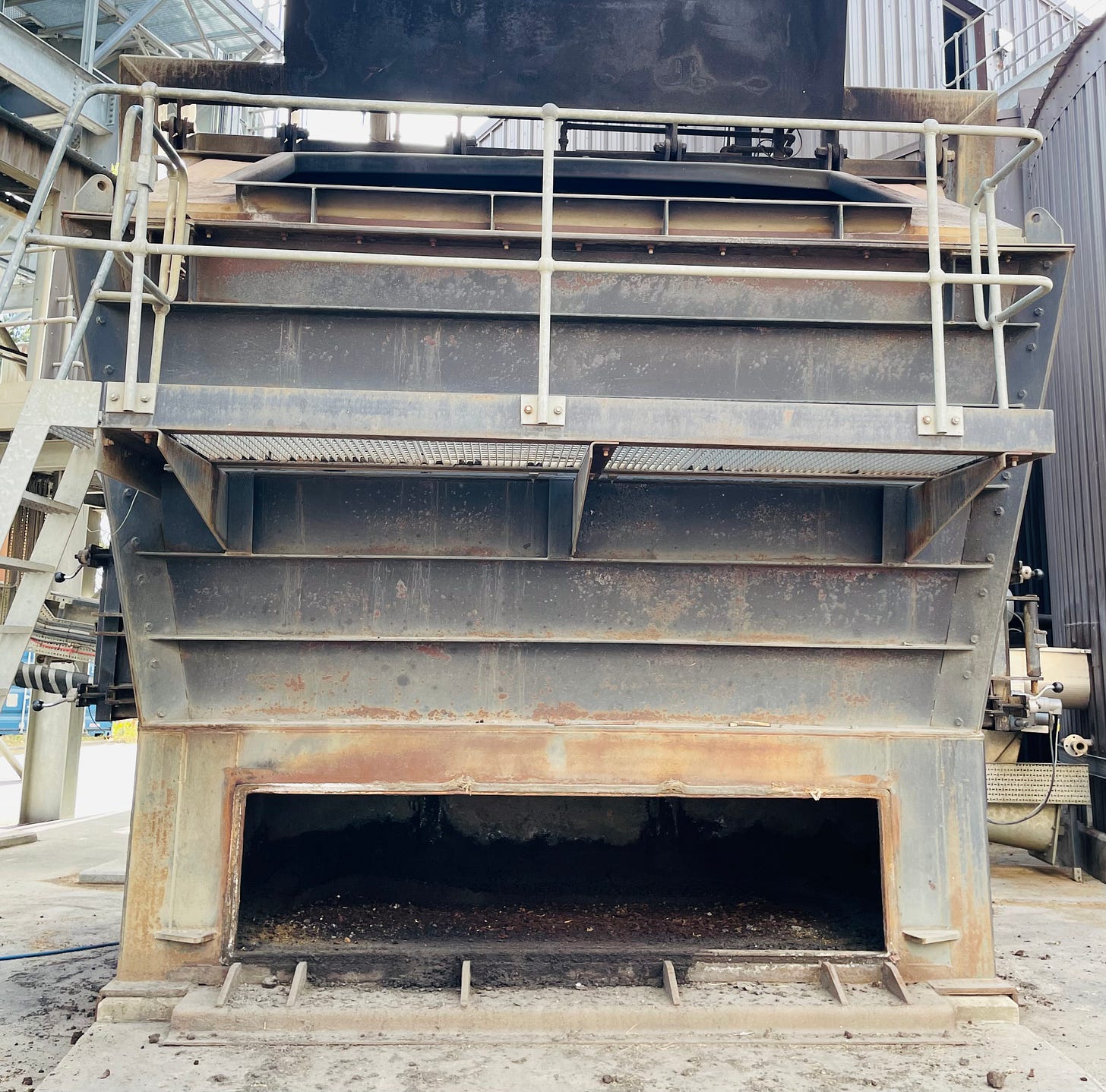In Conversation with Maltings Manager Andy Ballantyne
maltings intake, process, and the day-to-day
Vic and I sat down with maltster Andy Ballantyne, the maltings manager at Crisp Maltings in Portgordon to talk about what actually happens at a maltings: how barley is accepted (or rejected), how it runs through steeping, germination and kilning, what peat looks like from the malt house side, and what the last few harvests have been like.
We also asked him about some hotly debated topics, like if there really is salt in ‘coastal’ whiskies, and if barley variety affects flavour.
We started our interview in the boardroom at Crisp, during the busy intake season. Outside, lorries lined up for their initial checks, and the labs were abuzz. Then, Andy walked us around the maltings, into every building and crevice, to give us a long peak of the entire process.
What follows is a curated transcript, lightly edited for clarity, kept as close to Andy’s words as possible.
Shelly: Andy, for people who’ve never set foot in a maltings, what actually happens the minute a lorry arrives?
Andy: We turn the trucks around quick. First thing is a bug check. Then we set up germination tests—tetrazolium staining, aye—and we run screenings, nitrogen, moisture, and do a quick smell/sensory. If it’s out of spec, it’s rejected.
We’ve got long relationships with a few local farms nearby, and then everything else is through merchants. This year the merchants are more upset than the farmers, because we’re sticking to the numbers. Screenings have been the big one.
Vic: If it fails on screenings, is that just it?
Andy: Not always. If it’s just screenings, they’ll often dress the barley—take out the thinner corns, lose a bit of tonnage—and bring it back. But there’s no sense taking it if it’s not right. We’ve been accommodating for years; this year we don’t need to take barley in just to be nice.
Shelly: What about once it’s accepted; walk us through the plant.
Andy: The usual stages: steeps with air rests, into germination, then kiln. But how you do it matters. Our kit’s a bit older. We’ve three germination vessels and we don’t turn every 8–12 hours. It sits about 24 hours in one vessel, then we move it, and the main “turn” is the transfer through the conveying system. That regime suits Laureate. Diablo doesn’t run as nicely here. Could be technology and timings meeting the grain’s shape—seen similar at other sites.
Vic: What are distillers actually asking you for, number-wise?
Andy: Routine panel is moisture, nitrogen, screenings, germ tests. Then you’re watching friability and β-glucan downstream. Funny one—some distillers want derogations the other way: our friabilities are “too high.” We’re around 97% friability, which I’m happy with given the kit and the crop. We don’t usually variety-ID incoming barley—we take it as stated—but that might change. Audits want traceability end-to-end.
Shelly: How has this harvest behaved?
Andy: Moray’s been good. The East has been decimated. You get these nitrogen spikes with the weather—dry spell, then a deluge—the plant sucks up what’s soluble and the N goes straight to the head. We saw similar in 2018.
2023 was bad for nitrogen variability inside single loads, which gives you a headache in the plant. We’re stricter this year because the business needs us to be. We’ve even seen high DP at higher N on some lots. You only really feel it when you run it.
Vic: Let’s talk peat. What’s the view from the kiln?
Andy: I’m doing my Master Maltster project on recirculation of peat smoke—re-using the reek without hurting malt specs. Promising so far. Partly it’s neighbours—folk don’t like the smell, even if the maltings was there first. The old fix was taller chimneys. Recirc might be better—less discharge, and you still hit phenols.
Shelly: Big question we’re looking at: does barley variety change flavour?
Andy: My opinion? By the time it’s been through everything and matured, barley variety isn’t a huge driver. New make can differ—I know folk who’ve nosed Golden Promise vs Laureate and found differences—but to prove it in bottle you’d need exact same casks in the exact same warehouse. Otherwise it gets swamped. Operationally, varieties behave differently. As I said, Laureate processes well here; Diablo less so. We tried Diviner—mixed bag; seen β-glucan high on some. That’s the reality you meet on the floor.
Vic: You also had a strong view on coastal maturation.
Andy: How far from the coast your warehouse is…that’s critical. Coast regulates your warehouse with more consistent temperatures. Inland, you’re open to cold winters, warm summers, bigger swings. I’ve tasted a 1973 Glenglassaugh that stayed young and fresh—liquid gold—where other long sleepers can go too woody, too tannic. The coast can steady things.
Shelly: And the “salt in whisky” debate?
Andy: That’s one you could bust. There’s an Aberdeen University study that measured very little salt, even in whiskies folk call “salty.” It’s likely just association and perception.
Vic: On the business side, when did you feel the slowdown?
Andy: Three to four years ago you could see it coming. Post-COVID everyone over-produced, filled warehouses, and when it dipped there was nowhere to put whisky. Now bulk spirit’s easy to get. It works down the chain—distillers slow, then maltsters, then farmers. We’ve taken about two-thirds of our contracted barley so far; I doubt we’ll take the rest. Costs are up too—everything—so you’ll see barley dressers everywhere the next few weeks as folk try to bring loads back into spec.
Shelly: Final one: day-to-day reality at the maltings?
Andy: It’s the numbers and the people. Keep the specs, mind the neighbours, keep the plant safe, and get the barley through right. There’s been a lot of churn across the industry—you lose decades of tacit knowledge and bring in folk who are brilliant, but new. The old kit still needs hands that know its quirks. That’s the work.
From bug checks and tetrazolium at intake to air rests, germination vessels, and a kiln balancing peat and neighbours, Andy’s picture is the malt house as it is: spec-driven, weather-sensitive, kit-dependent, and right at the hinge between farms and stills. The romance comes later. The groundwork starts here.








